As a homeowner in Illinois or neighboring states, you need to be prepared for many eventualities that may affect your roof. The harsh climate of this region poses many different challenges for residents, which they should deal with as quickly as possible to avoid major consequences in the future. One of these challenges is algae growing on roof shingles, which is the subject of today’s post.
What Are Roof Algae?
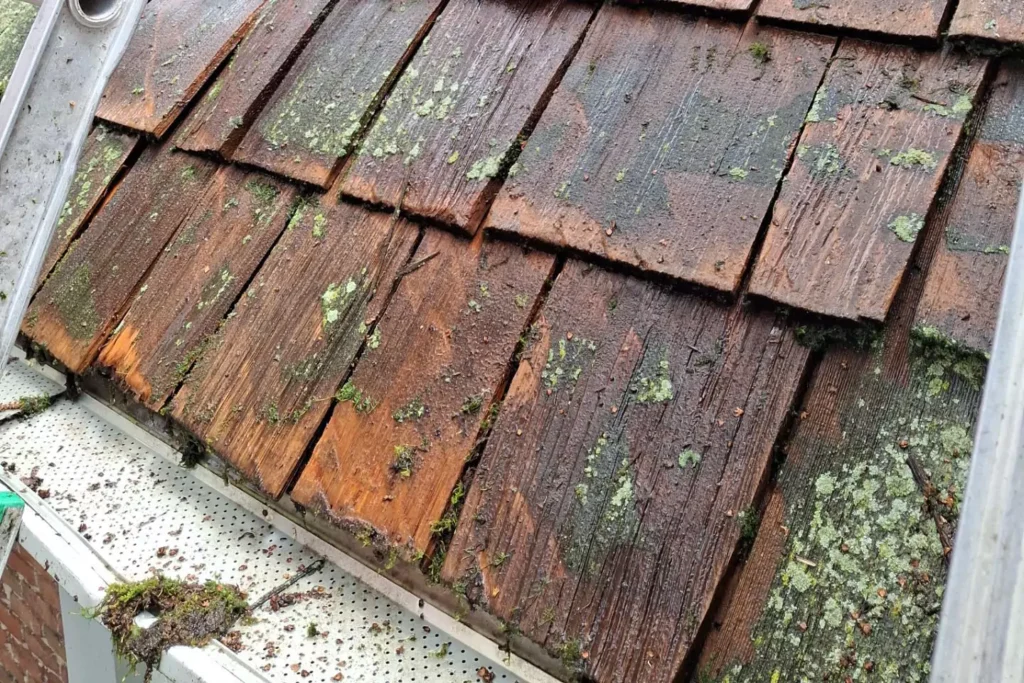
Algae that settle on roofs are autotrophic organisms, most often from the cyanobacteria or green algae group. Autotrophy is a mechanism that allows them to independently convert inorganic compounds (asphalt shingles in this case) into organic compounds, which they feed on. The process in question is commonly known as photosynthesis, i.e., the use of light energy and water to produce glucose. Therefore, in order for algae to grow, they need access to sunlight and water.
This state of affairs means that in some cases, the roof of a Chicagoland homeowner becomes a good place for them to grow. This is facilitated by the climate of northern Illinois, where summers are warm and sunny and the air is humid all year round. Frosty winters are also not an obstacle, as algae are able to effectively enter a state of dormancy by producing thicker cell walls that help them survive the cold. Algae do not actively photosynthesize during this time, but wait for better conditions. As soon as late spring arrives, algae become active and continue to grow.
What does this mean for the roof owner? It basically means that if you don’t remove them one year, they will continue to grow the next. Therefore, you should definitely not wait for conditions to improve or hope that winter will defeat them, because they are clever organisms that can adapt to different conditions. Delaying their removal may result in much higher costs in the future, as algae can damage your roof.
On What Types of Roofing Does Algae Appear?
It turns out that algae does not attack all roofs, but only those with roofing materials that are susceptible to it. For example, metal roofs, due to their smooth surface and bright, reflective finish, provide difficult conditions for algae growth. A low susceptibility to any microorganisms is actually one of the biggest advantages of metal roofs and it’s one of the reasons why steel is such a popular roofing material in Florida.
Unfortunately, the most popular material in the entire country, asphalt shingles, is very susceptible to algae growth. Even though there are algae-resistant shingles (produced by GAF and Owens Corning), their rough surface still creates ideal conditions for algae to grow. The same applies to cedar shingles or shakes — moist wood is also a good place for them to grow. Algae can also grow on some kinds of terracotta and concrete roofs due to their porous surface.
Are Algae a Threat to Your Roof Shingles?
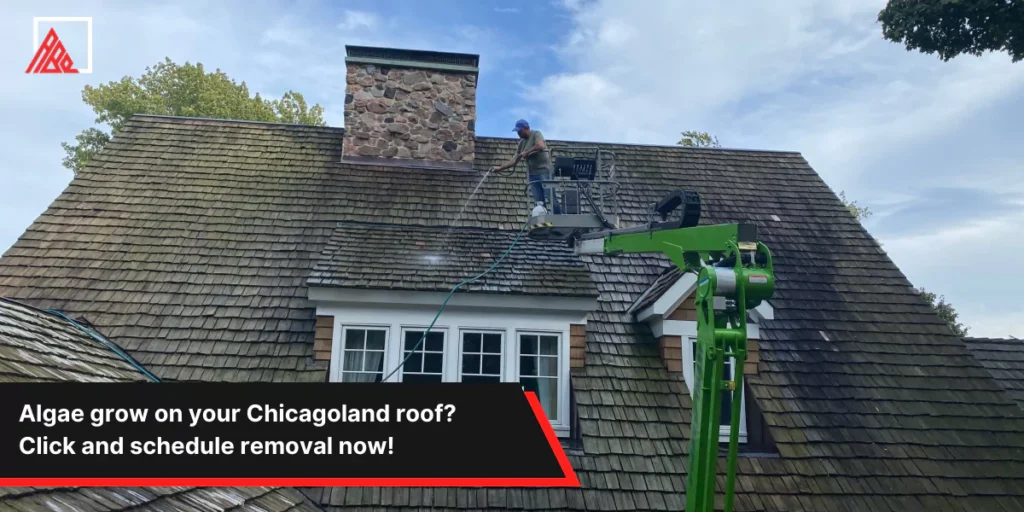
The issue of algae is somewhat complicated, because algae themselves do not pose a critical threat to the roof.The only truly negative factor that is immediately visible and directly caused by algae is the aesthetic effect. Algae form dark green or black streaks (algae stain), making the roof look old, dirty, and neglected. Major changes are easily visible from ground level, so even if you don’t notice them, your neighbors and passersby certainly will. In this scenario, a slight shingle discoloration is a just minor inconvenience.
The second issue is the impact of algae on the condition of the material. In the case of asphalt shingles, algae settling on the surface weaken the protective layer of mineral granules, which can accelerate the aging of the material. This also negatively affects UV resistance, as this task belongs to the granule layer. Similar consequences are caused by the growth of algae on cedar shingles. Although their structure is completely different, wood exposed to long-term algae growth also ages faster, due to the appearance of microcracks or warping of the shingles.
It is also important to note that the presence of algae contributes to the development of various other problems that can further accelerate the aging process and cause actual damage that weakens the condition of the material. Namely, algae, through their ability to absorb and retain water, create an excellent basis for the appearance of mosses and lichens. Moss spores readily settle on the moist surface of algae and grow there.
Moss is a real threat to the material because it starts to grow between the shingles and penetrate their edges. In doing so, it also retains water. Penetrating under the shingles lifts them, slowly weakening the tightness of the entire structure. In the case of cedar shingles, there is also the issue of lichen growth, which, combined with constant moisture, weakens the chemical resistance of the wood. The whole mechanism is self-perpetuating, and the roof becomes increasingly damaged.
At the end of the day, affected areas are more likely to leak or get damaged by any other stressors, such as falling branches or hail. While algae is usually not as dangerous for roofing system as the moss is, you should definitely prevent it from growing.
I Noticed Algae On My Roof – What Should I Do?
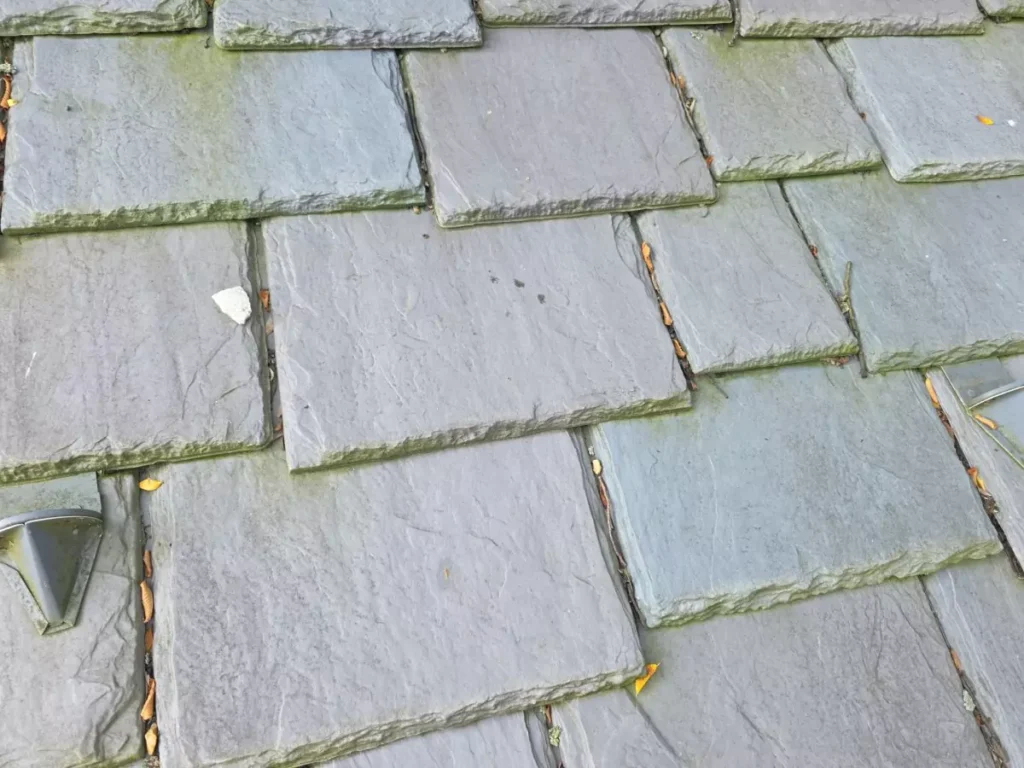
You already know what algae are and what dangers they pose. So what should you do if you notice that they have started to grow on your roof? This section will be divided into instructions for owners of asphalt shingle roofs, wooden shingle roofs, and concrete roofs.
If you decide to clean it yourself, don’t forget to prepare properly and stay safe. Choose a relatively cool day, preferably cloudy, so that the product can work effectively. It is also a good idea to protect any plants that may come into contact with the product after it has been rinsed off the roof. Remember that if your roof is more challenging — very high or steep — it is a good idea to hire a professional who has the right equipment and safety measures in place.
Regardless of the type of roof you have, you should first assess its condition. Check the condition of the shingles or tiles, whether algae has settled on them, and whether moss or other lichens have appeared. If the material is cracked, crumbled, or lifting, this is a very bad sign — it may be a sign that part of the roofing needs to be replaced. These factors also determine whether you can deal with the algae yourself or whether it would be better to call a professional. The presence of moss and other lichens means that home remedies may not be enough and stronger chemicals will be needed, which will also be safe for the shingles themselves.
Asphalt Shingles
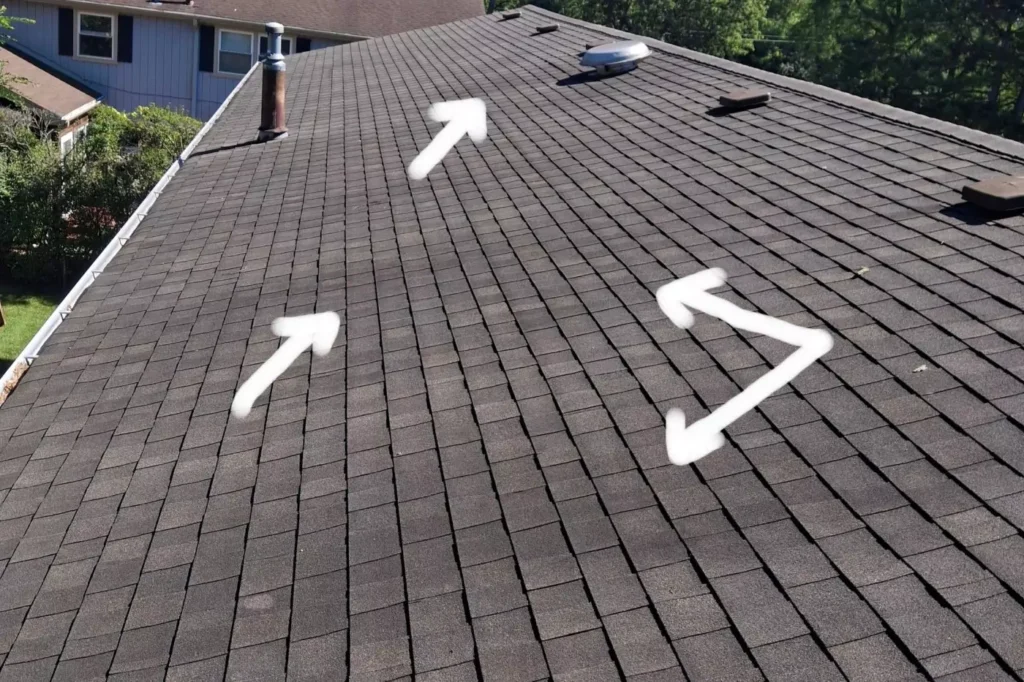
If the shingles are in good condition and the roof pitch doesn’t exceed 7/12, you can try to deal with them yourself. To do this, prepare a mixture of chlorine bleach and water in a 1:1 ratio or purchase a special algae remover.
Under no circumstances should you use a pressure washer, as it can damage the shingles by removing the mineral granules. The best idea is to use a regular garden sprayer and spray the solution onto the algae-covered shingles. After applying the mixture, wait 15-20 minutes and rinse the roof with water. After a few days, you should see the algae die off. If the algae do not die completely within 4-6 weeks, you can spray them a second time.
Keep in mind, however, that you should avoid cleaning the shingle roof with hard brush, as it also can remove the mineral granules. If there’s a need to use a brush, try to find a soft one.
Cedar Shingles and Shakes
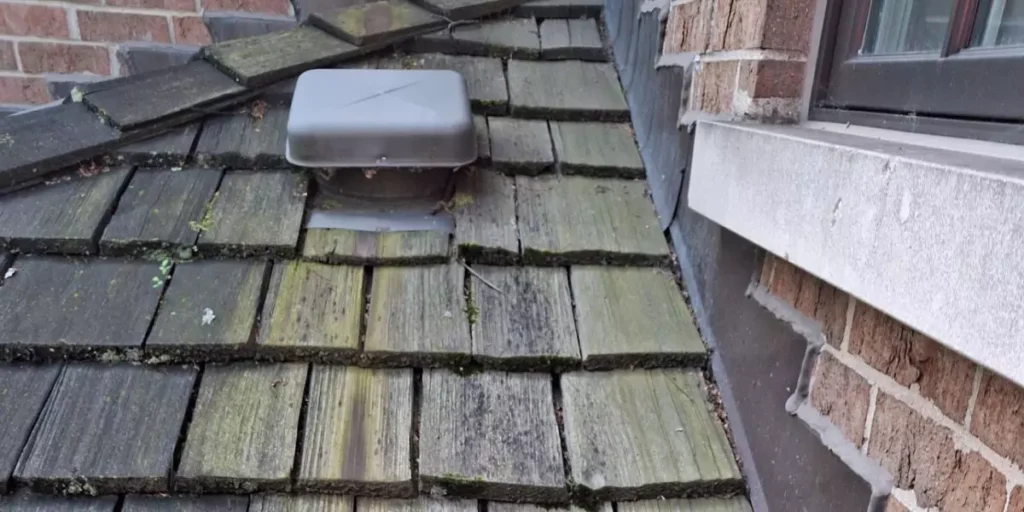
Cedar shingles, due to the sensitivity of wood to harsh chemicals, require a slightly gentler cleaning method. In this case, a mixture of water and chlorine bleach will be too strong for the material, so it is better to use oxygen bleach. To make it, add 1 cup of sodium percarbonate to 4 liters of warm water.
Such a mixture will produce a mild agent that will remove algae. Spray the algae with a garden sprayer and leave for 15-20 minutes, then scrub with a soft nylon brush along the grain of the wood (scrubbing in a transverse direction may damage the structure of the material). After thorough scrubbing, rinse everything with water at a minimum pressure (maximum 800 psi).
In the case of cedar shingles, impregnation is very important. After about 2 days, when the roof is dry, apply a water-repellent and antifungal impregnation. This will make the wood less absorbent and make it much more difficult for algae to return.
Concrete and Ceramic Roof Tiles
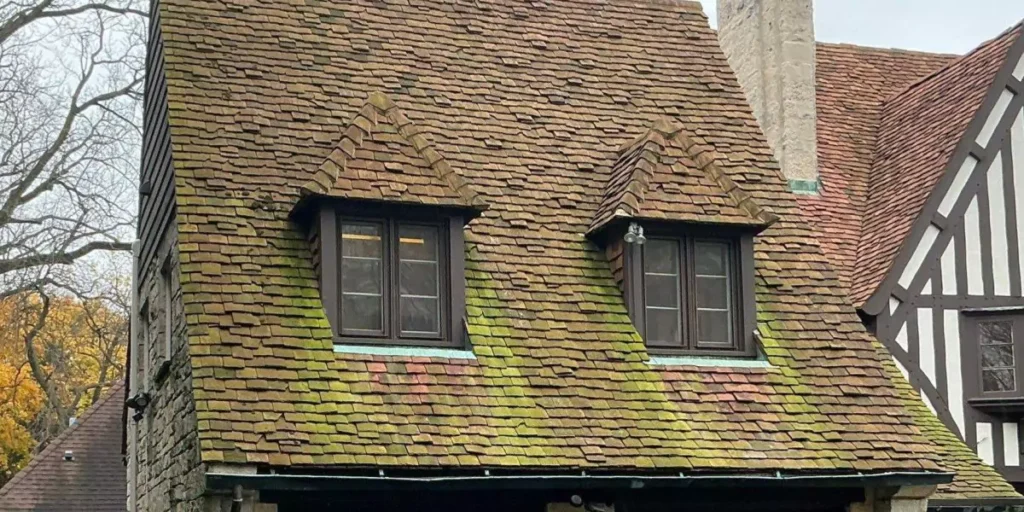
In the case of concrete roof, the method of cleaning them yourself is very similar to that used for cedar shingles. You should also avoid using a pressure washer and gently spray the product with a garden sprayer. Due to differences in the composition of the materials, oxygen bleach is not suitable in this case. You will need a stronger agent, for example, one based on sodium hypochlorite. It is best to go to your local hardware store and look for a suitable product. After application, wait several minutes and brush gently. After rinsing the product with low-pressure water, wait for the roof to dry, then apply a water-repellent agent.
As algae is more difficult to remove from concrete than from cedar, you may need to use more power to brush the roof properly.
Is There a Way to Prevent Algae To Grow On My Roof?
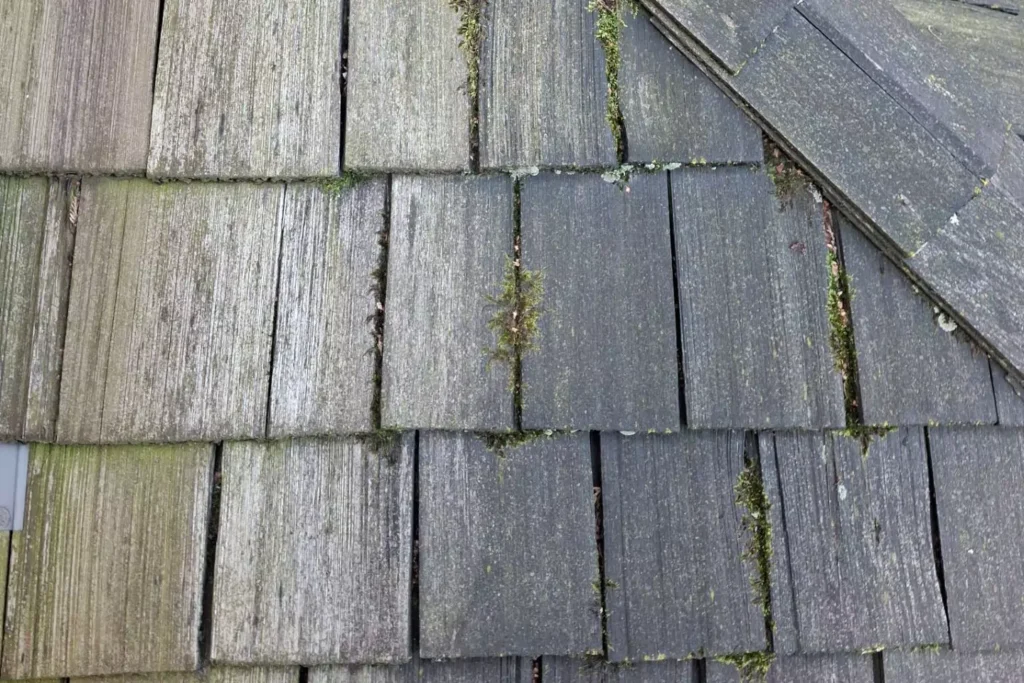
Since the early 2000’s, roof manufacturers have been conducting research in order to create algae-resistant roofing materials. While microorganisms are hardly ever a serious threat to the integrity, roof discoloration affects negatively on the house resale value. What’s even more important, homeowners disappointed with particular model of shingles would not install them anymore. Thus, lots of money was spent in order to develop the technology able to inhibit algae growth.
Despite this serious commission and millions of dollars spent, there’s no way to prevent future algae growth on asphalt roofs, but there are way delay and minimize occurrence of this problem.
The most popular method of algae protection is metal – producers such as GAF cover their shingles with special copper microsites, releasing ions this way. The same thing can be achieved with ions of silver or zinc. Thinking this way, some roofing contractors try to cover existing roof with silver, zinc or copper dust.
On the Internet you can also find people who claim that they use zinc or copper strips nailed to the ridge. As they say, when the rain falls down, the metal releases the ions, thus inhibiting the growth of algae and moss. We don’t use this technique, so we don’t want to judge if it works actually.
For now, probably the best way to prevent moss and algae growth on asphalt roof is a simple cleaning with use of chemicals strong enough to kill all the microorganisms. Regular roof maintenance gives you 100% of success rate and at the same time, it’s the cheapest option.
Is It Worth Hiring a Roofing Professional for Roof Cleaning?

Definitely yes. While some homeowners can remove algae without damaging their roof, we have seen hundreds of homes where maintenance wasn’t conduct in a proper way. Without experience, you may simply damage shingles, or just remove only a part of algae.
You should also remember that going onto the roof might be simply dangerous for you. Many roofs, especially older ones, are slippy, so standing there becomes risky. You can obviously avoid it by using special equipment, such as safety harness, but virtually no one has such a thing at home.
At the very end, you should also be aware of the surprisingly low price of such a service. In most of the cases, we charge as little as $350-$650 for a thorough and comprehensive roof maintenance, including the cost of gutter cleaning. Do you really want to risk that much to save three hundred dollars?
Summary
Algae are very clever and malicious organisms – once they start growing on your roof, there is no way they will stop on their own. Although algae itself does not destroy roofing material, its growth can lead to real damage to the roof over time. This is because algae creates ideal conditions for the growth of moss and other lichens, which damage both shingles and tiles.
Therefore, if you notice algae on your roof, be sure to take action as soon as possible and protect your roof for the future. If your roofing material is in good condition and the roof itself does not require any special safety measures, there is a very good chance that you can deal with the algae yourself, using a home remedy.
If the roofing material is seriously damaged (cracked, holey, loose) and algae appear on it, it is a good idea to contact a professional who will be able to assess whether it is worth removing the algae with special products or whether it would be more cost-effective to replace part of the material.

